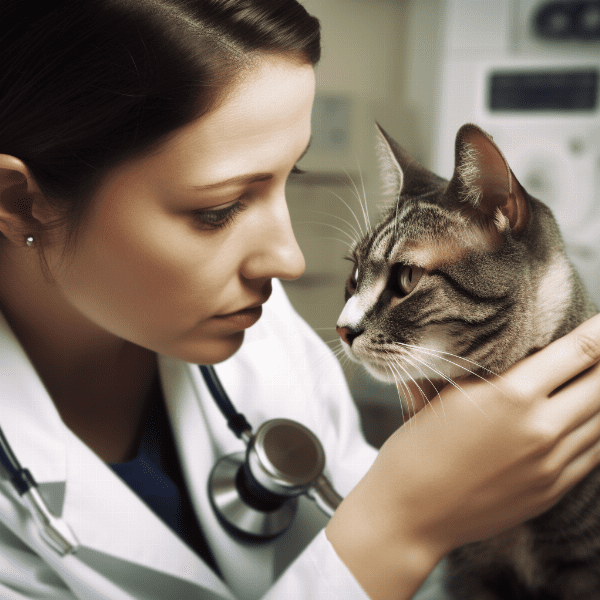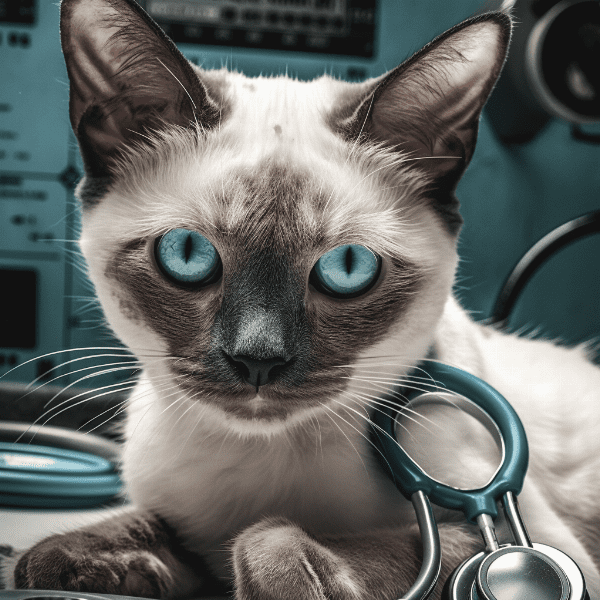Table of Contents
- Understanding Feline Ear Cancer
- Common Symptoms of Feline Ear Cancer
- Diagnosis of Feline Ear Cancer
- Treatment Options for Feline Ear Cancer
- Surgery for Feline Ear Cancer
- Radiation Therapy for Feline Ear Cancer
- Chemotherapy for Feline Ear Cancer
- Palliative Care for Feline Ear Cancer
- Caring for a Cat with Ear Cancer
- Prevention of Feline Ear Cancer
Understanding Feline Ear Cancer
Feline ear cancer, also known as feline aural squamous cell carcinoma, is a type of cancer that affects a cat’s ear canal. This type of cancer is more commonly found in older cats and is often linked to excessive exposure to the sun. While the exact cause of feline ear cancer is unknown, studies have shown that cats with white ears and those that spend a lot of time in the sun are at a higher risk of developing the condition.
How Does Feline Ear Cancer Develop?
Feline ear cancer develops when the cells in a cat’s ear canal mutate and grow uncontrollably. These cells can form tumors that can grow and spread to other parts of the body if left untreated. In some cases, the tumors can cause damage to the ear canal, leading to hearing loss and other complications.
Types of Feline Ear Cancer
There are several types of feline ear cancer, but the most common type is squamous cell carcinoma. This type of cancer affects the cells that line the ear canal and can spread quickly to other parts of the body. Other types of feline ear cancer include basal cell carcinoma, melanoma, and adenocarcinoma.
Risk Factors for Feline Ear Cancer
As mentioned, cats with white ears and those that spend a lot of time in the sun are at a higher risk of developing feline ear cancer. Other risk factors include exposure to cigarette smoke, chronic ear infections, and certain viruses such as feline leukemia virus.
Conclusion
Understanding feline ear cancer is important for all cat owners. Knowing the risk factors and symptoms of the condition can help with early detection and treatment, leading to better outcomes for your feline companion. If you suspect that your cat may have feline ear cancer, it is important to seek veterinary care as soon as possible to discuss the best treatment options available.

Common Symptoms of Feline Ear Cancer
Feline ear cancer can present itself in a variety of ways, and the symptoms may vary depending on the stage of the cancer. It’s important for cat owners to be aware of the common symptoms of feline ear cancer so that they can seek veterinary care as soon as possible.
Early Stage Symptoms
In the early stages of feline ear cancer, your cat may not exhibit any obvious symptoms. However, some cats may experience mild discomfort, head shaking, or ear scratching. These symptoms may be mistaken for a common ear infection or ear mites.
Advanced Stage Symptoms
As the cancer progresses, more noticeable symptoms may appear. These symptoms can include bleeding from the ear, a foul odor coming from the ear, and a discharge from the ear. Your cat may also show signs of pain when touching the ear, lose their balance or coordination, and experience hearing loss. In some cases, the tumor may become visible as a lump or mass in the ear canal.
Other Possible Symptoms
Feline ear cancer can also cause other symptoms in your cat, such as weight loss, loss of appetite, and lethargy. These symptoms can be caused by the cancer itself or by the stress of dealing with the illness.
Conclusion
Recognizing the symptoms of feline ear cancer is essential for early detection and treatment. If you notice any of the symptoms mentioned above, it’s important to seek veterinary care as soon as possible. Your veterinarian can perform diagnostic tests to determine the cause of the symptoms and recommend appropriate treatment options. With prompt diagnosis and treatment, your cat can have the best chance of recovery and a good quality of life.

Diagnosis of Feline Ear Cancer
Diagnosing feline ear cancer requires a thorough examination by a veterinarian. The vet will take a detailed history of your cat’s symptoms and perform a physical exam, which may include a visual inspection of the ear canal, as well as palpation of the lymph nodes and other areas around the ear.
Diagnostic Tests
To confirm a diagnosis of feline ear cancer, the veterinarian may recommend further diagnostic tests. These tests may include:
- Imaging Tests: X-rays, ultrasound, and CT scans can be used to visualize the tumor and determine its size and location.
- Biopsy: A biopsy involves taking a small sample of the tumor tissue and examining it under a microscope. This test can confirm the type of cancer and its severity.
- Blood Work: Blood tests can help determine if the cancer has spread to other areas of the body.
Anesthesia
In some cases, a cat may need to be placed under anesthesia to perform diagnostic tests such as a biopsy or CT scan. Anesthesia is used to ensure that the cat remains still during the procedure and does not experience any pain or discomfort.
Conclusion
Diagnosing feline ear cancer can be challenging, but with the right diagnostic tests, a veterinarian can confirm a diagnosis and develop a treatment plan tailored to your cat’s specific needs. If you suspect that your cat may have feline ear cancer, it’s important to seek veterinary care as soon as possible to ensure that your cat receives prompt and appropriate treatment.

Treatment Options for Feline Ear Cancer
There are several treatment options available for feline ear cancer, and the best treatment plan will depend on the type and stage of the cancer, as well as the cat’s overall health and other individual factors. Some common treatment options include:
Surgery
Surgery is often the preferred treatment for feline ear cancer. During surgery, the tumor and any affected tissue are removed from the ear canal. In some cases, the entire ear may need to be removed if the cancer has spread extensively. Surgery may also be combined with radiation therapy or chemotherapy to help prevent the cancer from returning.
Radiation Therapy
Radiation therapy involves using high-energy radiation to kill cancer cells. This treatment is often used in conjunction with surgery to help prevent the cancer from returning. Radiation therapy may also be used as the primary treatment option for cats that are not good surgical candidates.
Palliative Care
In some cases, treatment may not be curative, and the focus may shift to providing palliative care to improve the cat’s quality of life. This may include pain management, nutritional support, and other supportive measures to keep the cat comfortable.
Conclusion
Feline ear cancer is a serious condition, but there are treatment options available to help manage the cancer and improve the cat’s quality of life. Working closely with a veterinarian to develop a treatment plan that is tailored to the cat’s individual needs is essential for the best possible outcome. With prompt diagnosis and appropriate treatment, many cats with feline ear cancer can go on to live happy and healthy lives.

Surgery for Feline Ear Cancer
Surgery is a common treatment option for feline ear cancer. The goal of surgery is to remove the tumor and any affected tissue from the ear canal. The type of surgery needed will depend on the size and location of the tumor, as well as the stage of the cancer. In some cases, the entire ear may need to be removed if the cancer has spread extensively.
Surgical Procedure
The surgical procedure for feline ear cancer typically involves general anesthesia to ensure that the cat remains still and comfortable during the procedure. The surgeon will make an incision in the ear canal and carefully remove the tumor and any affected tissue. The surgeon will also take steps to preserve as much of the cat’s hearing as possible.
Post-Surgical Care
After surgery, the cat will need to stay in the hospital for a period of time to recover from the anesthesia and to be monitored for any signs of complications. The cat will also need to wear a protective collar or bandage to prevent them from scratching or damaging the surgical site.

Radiation Therapy for Feline Ear Cancer
Radiation therapy is a common treatment option for feline ear cancer. This treatment involves using high-energy radiation to kill cancer cells and prevent the cancer from spreading. Radiation therapy is often used in conjunction with surgery to help prevent the cancer from returning.
Radiation Therapy Procedure
During radiation therapy, the cat is placed under anesthesia to ensure that they remain still and comfortable during the procedure. The radiation is then delivered to the affected area using a specialized machine. The radiation is carefully targeted to avoid damaging healthy tissue.

Chemotherapy for Feline Ear Cancer
Chemotherapy is a treatment option for feline ear cancer that involves using drugs to kill cancer cells. This treatment is often used in cases where the cancer has spread to other parts of the body or is inoperable. Chemotherapy can be given orally or through injections.
Pre-Treatment Consultation
Before chemotherapy can begin, a veterinarian will perform a thorough physical examination of the cat and may recommend diagnostic tests such as imaging or blood work. This will help determine the extent of the cancer and the appropriate chemotherapy approach.
Chemotherapy Procedure
During chemotherapy, the cat may need to stay in the hospital for a period of time to receive the treatment. Chemotherapy drugs are given in cycles, with rest periods in between to allow the cat’s body to recover. The drugs can have side effects such as nausea, vomiting, and hair loss.
Post-Treatment Care
After chemotherapy, the cat may experience side effects such as fatigue, loss of appetite, and diarrhea. The veterinarian will provide instructions on how to manage these side effects and will monitor the cat closely for any signs of complications.
Follow-Up Care
After chemotherapy, the cat will need to be monitored closely for any signs of recurrence or complications. The veterinarian may recommend additional treatments such as radiation therapy to help prevent the cancer from returning.
Conclusion
Chemotherapy is a treatment option for feline ear cancer that can be effective in managing the disease. With careful pre-treatment planning and appropriate post-treatment care, many cats can recover from chemotherapy and go on to live happy and healthy lives. If you suspect that your cat may have feline ear cancer, it’s important to seek veterinary care as soon as possible to discuss the best treatment options available.

Palliative Care for Feline Ear Cancer
In some cases, treatment for feline ear cancer may not be curative, and the focus may shift to providing palliative care to improve the cat’s quality of life. Palliative care is a type of care that is focused on relieving symptoms and improving the overall well-being of the cat.
Pain Management
Pain management is an important aspect of palliative care for feline ear cancer. The veterinarian may recommend pain medications such as opioids or non-steroidal anti-inflammatory drugs (NSAIDs) to help manage pain and discomfort.
Nutritional Support
Cats with feline ear cancer may experience a loss of appetite or difficulty eating due to the cancer or the side effects of treatment. Nutritional support, such as feeding the cat a high-quality, nutrient-dense diet or providing nutritional supplements, can help maintain the cat’s strength and overall well-being.
Emotional Support
Cats with feline ear cancer may experience stress or anxiety due to the illness and changes in their daily routine. Providing emotional support, such as spending quality time with the cat, playing with them, and providing a comfortable and familiar environment, can help alleviate stress and improve their overall well-being.
Conclusion
Palliative care can play an important role in improving the quality of life for cats with feline ear cancer. Working closely with a veterinarian to develop a palliative care plan that is tailored to the cat’s individual needs is essential for the best possible outcome. With appropriate palliative care, cats with feline ear cancer can live comfortably and enjoy a good quality of life.

Caring for a Cat with Ear Cancer
Caring for a cat with ear cancer can be challenging, but there are steps that you can take to ensure that your cat receives the best possible care.
Follow the Treatment Plan
Following the treatment plan recommended by the veterinarian is essential for managing feline ear cancer. This may include surgery, radiation therapy, chemotherapy, or palliative care. Be sure to follow the veterinarian’s instructions for administering medications, attending follow-up appointments, and monitoring your cat’s progress.
Monitor Your Cat’s Symptoms
Monitoring your cat’s symptoms is an important part of caring for a cat with ear cancer. Keep a close eye on your cat’s behavior, appetite, and energy level, and report any changes to the veterinarian right away. Early detection of recurrence or complications can improve the chances of successful treatment.
Provide Nutritious Food and Fresh Water
Providing your cat with a nutritious diet and fresh water is important for maintaining their strength and overall health. Cats with feline ear cancer may experience a loss of appetite or difficulty eating, so it’s important to offer a variety of tasty and nutritious foods to encourage eating.
Create a Comfortable Environment
Creating a comfortable and familiar environment can help reduce stress and anxiety for cats with feline ear cancer. Provide your cat with a comfortable bed, toys, and a quiet space to rest. Consider using pheromone sprays or diffusers to help promote relaxation.
Conclusion
Caring for a cat with ear cancer requires dedication and commitment, but with the right care and treatment, many cats can live happy and healthy lives. Working closely with a veterinarian to develop a treatment and care plan that is tailored to your cat’s individual needs is essential for the best possible outcome. With proper care and attention, cats with feline ear cancer can continue to enjoy their lives and the love and companionship of their human family.

Prevention of Feline Ear Cancer
Preventing feline ear cancer can be challenging, but there are steps that cat owners can take to help reduce the risk.
Protect Your Cat from Sun Exposure
Exposure to sunlight can increase the risk of certain types of skin cancer, including squamous cell carcinoma, which can affect the ears. To reduce the risk of feline ear cancer, limit your cat’s exposure to sunlight, especially during peak hours, and provide plenty of shade for outdoor activities.
Regular Veterinary Check-Ups
Regular check-ups with a veterinarian can help detect any signs of feline ear cancer early, increasing the chances of successful treatment. Be sure to schedule routine check-ups at least once a year, and report any changes in your cat’s behavior, appetite, or energy level to the veterinarian right away.
Avoid Exposure to Environmental Toxins
Exposure to certain environmental toxins can increase the risk of feline ear cancer. To reduce the risk, avoid exposing your cat to second-hand smoke, chemicals, and other environmental toxins.
Provide a Nutritious Diet
Providing your cat with a nutritious diet can help promote overall health and reduce the risk of certain types of cancer, including feline ear cancer. Be sure to offer a high-quality, balanced diet that meets your cat’s individual needs.
Conclusion
Preventing feline ear cancer may not be entirely possible, but there are steps that cat owners can take to help reduce the risk. Protecting your cat from sun exposure, scheduling regular check-ups with a veterinarian, avoiding exposure to environmental toxins, and providing a nutritious diet can all help promote overall health and reduce the risk of cancer. If you suspect that your cat may have feline ear cancer, it’s important to seek veterinary care as soon as possible to discuss the best treatment options available.




